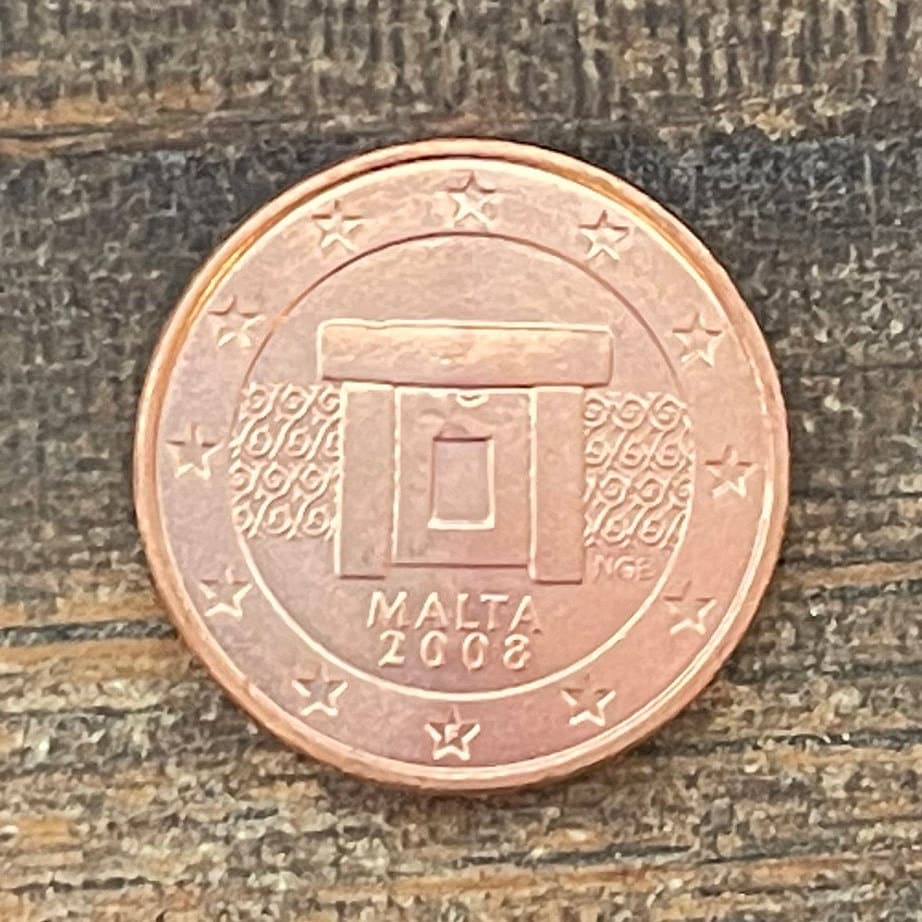elemintalshop
Mnajdra Megalithic Goddess Temple 1 Euro Cent Malta Authentic Coin Money for Jewelry and Craft Making (Fertility)
Mnajdra Megalithic Goddess Temple 1 Euro Cent Malta Authentic Coin Money for Jewelry and Craft Making (Fertility)
Couldn't load pickup availability
Mnajdra Megalithic Goddess Temple 1 Euro Cent Malta Authentic Coin Money for Jewelry and Craft Making (Fertility)
Obverse: Mnajdra Megalithic Temple along with the country name and date below. The coin's outer ring bears the 12 stars of Europe.
Lettering:
MALTA
2008
Reverse: A globe, next to the face value, shows Europe in relation to Africa and Asia.
Lettering: 1 EURO CENT
Features
Issuer Malta
Period Republic (1974-date)
Type Standard circulation coin
Years 2008-2021
Value 1 Euro Cent
0.01 EUR = USD 0.011
Currency Euro (2008-date)
Composition Copper plated steel
Weight 2.3 g
Diameter 16.25 mm
Thickness 1.67 mm
Shape Round
Technique Milled
Orientation Medal alignment ↑↑
Number N# 2181
References KM# 125
WIkipedia:
Mnajdra (Maltese: L-Imnajdra) is a megalithic temple complex found on the southern coast of the Mediterranean island of Malta. Mnajdra is approximately 500 metres from the Ħaġar Qim megalithic complex. Mnajdra was built around the fourth millennium BCE; the Megalithic Temples of Malta are among the most ancient religious sites on Earth, described by the World Heritage Sites committee as "unique architectural masterpieces." In 1992 UNESCO recognized the Mnajdra complex and four other Maltese megalithic structures as UNESCO World Heritage Sites.
Contemporary interpretations
Anthropologist Kathryn Rountree has explored how "Malta’s neolithic temples", including Ġgantija, "have been interpreted, contested and appropriated by different local and foreign interest groups: those working in the tourist industry, intellectuals and Maltese nationalists, hunters, archaeologists, artists, and participants in the global Goddess movement."
One source from the early years of the twenty-first century speculates that the clover-shape of Mnajdra (presumably the Upper Temple) may represent "the present, past and future (or birth, life and death)", while the solar alignment could mean that "the Sun's Male-energy is also given an honored place in these temples", and that "mother earth was represented by statuettes while father sun was venerated through this temple alignment."
Functions
Dressed limestone
The lowest temple is astronomically aligned and thus was probably used as an astronomical observation and/or calendrical site. On the vernal and the autumnal equinox sunlight passes through the main doorway and lights up the major axis. On the solstices sunlight illuminates the edges of megaliths to the left and right of this doorway.
Although there are no written records to indicate the purpose of these structures, archaeologists have inferred their use from ceremonial objects found within them: sacrificial flint knives and rope holes that were possibly used to constrain animals for sacrifice (since various animal bones were found). These structures were not used as tombs since no human remains were found. The temples contain furniture such as stone benches and tables that give clues to their use. Many artifacts were recovered from within the temples suggesting that these temples were used for religious purposes, perhaps to heal illness and/or to promote fertility.
Share



















